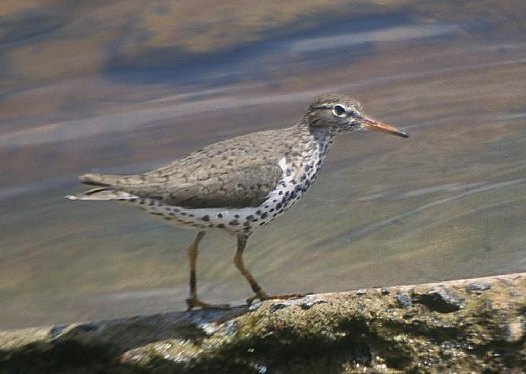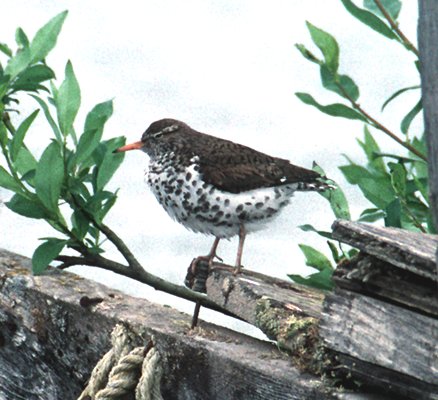| Spotted Sandpiper
Actitis macularia Andarríos Coleador, |
 |
|
Non-breeding plumage -
Photo: G. Beaton
|
| Spotted Sandpiper
Actitis macularia Andarríos Coleador, |
 |
|
Non-breeding plumage -
Photo: G. Beaton
|
|
IDENTIFICATION: A shorebird with an olive-brown back, a white eye line, and white underparts with round spots. The bill is reddish orange with a black tip. In winter the spots are lacking, and the back and bill are duller. Length: 18-20 cm.; weight: females 43-50 g., males 34-41 g. VOICE: A double call note, often given in flight or when alarmed, "weet weet." Audio 3 (M. Oberle). HABITAT: A wide variety of wetlands including rocky shores, mangroves, mudflats, lake shores, and river banks. HABITS: The Spotted Sandpiper can be recognized from far away by its unique habit of bobbing its body up and down as it walks---or even when standing in one place. It flies with shallow, quick bursts of its wings, which it points stiffly downward between bursts of wing beats. It feeds alone on insects and other invertebrates, and less commonly on small fish, if it can catch them. One study in Puerto Rico found that mole crickets (Scapteriscus didactylos) were important insect prey. The Spotted Sandpiper is one of only 0.2% of all bird species with a reversal of sex roles. The females instead of the males migrate first to breeding grounds in North America, and establish breeding territories, often before the males arrive. The female is larger and more aggressive in courting the male and will sometimes have 2-4 mates (polyandry). Each male defends its own nesting territory within the female’s larger territory. The female assists each male in building a simple nest: a scrape in the soil, lined with grass. Although both sexes incubate the eggs and brood the young, the male does most of the work. In contrast to most species during the breeding season, the male has higher blood levels of the hormone prolactin: a hormone that regulates parenting behavior. A typical clutch contains 1-4 eggs, and incubation lasts about 21 days. The chicks leave the nest a few hours after hatching, can feed themselves within a few days, and can fly about 18 days after hatching. STATUS AND CONSERVATION: A common winter visitor. RANGE: Breeds from central California and Virginia north to the edge of the tundra in Alaska and Canada. It winters from the southern USA, south through Central America and the islands of the Caribbean, to northern Chile and central Argentina. TAXONOMY: CHARADRIIFORMES; SCOLOPACIDAE; Scolopacinae |
 |
|
Breeding plumage - Photo: G. Beaton
|
 |
|
Breeding plumage - Photo: G. Beaton
|
 |
|
Breeding plumage - Photo: G. Beaton
|
 |
|
Photo: R. Rodríguez Mojica
|
 |
|
Non-breeding plumage - Photo: G. Beaton
|
|
References Bent, A.C. 1929. Life histories of North American shore birds, part 2. Smithsonian Instit. U.S. National Museum Bull. 146. (Reprinted by Dover Press, NY, 1962). Collazo, J.A., B.A. Harrington, J. Grear, and J.A. Colón. 1995. Abundance and distribution of shorebirds at the Cabo Rojo salt flats, Puerto Rico. J. Field Ornithol. 66:424-438. del Hoyo, J., A. Elliott, and J. Sargatal, eds. 1996. Handbook of Birds of the World, Vol. 3. Hoatzin to Auks. Lynx Edicions, Barcelona. Hayman, P., J. Marchant, and T. Prater. 1986. Shorebirds: an identification guide. Houghton Mifflin, Boston. Oring, L.W., E.M. Gray, and J.M. Reed. 1997. Spotted Sandpiper (Actitis macularia). No. 289 in The birds of North America (A. Poole and F. Gill, eds.). Acad. Nat. Sci., Philadelphia, PA, and Am. Ornithol. Union, Washington, D.C. Paulson, D. 1993. Shorebirds of the Pacific Northwest. Univ Washington, Seattle. Saliva, J.E. 1994. Vieques y su fauna: Vieques wildlife manual. U.S. Fish & Wildlife Service, Boquerón, PR. Wunderle, J.M., Jr., R.B. Waide, and J. Fernández. 1989. Seasonal abundance of shorebirds in the Jobos estuary in southern Puerto Rico. J. Field Ornithol. 60:329-339. Spotted Sandpiper, Spanish text Next related species in taxonomic order Previous related species in taxonomic order |